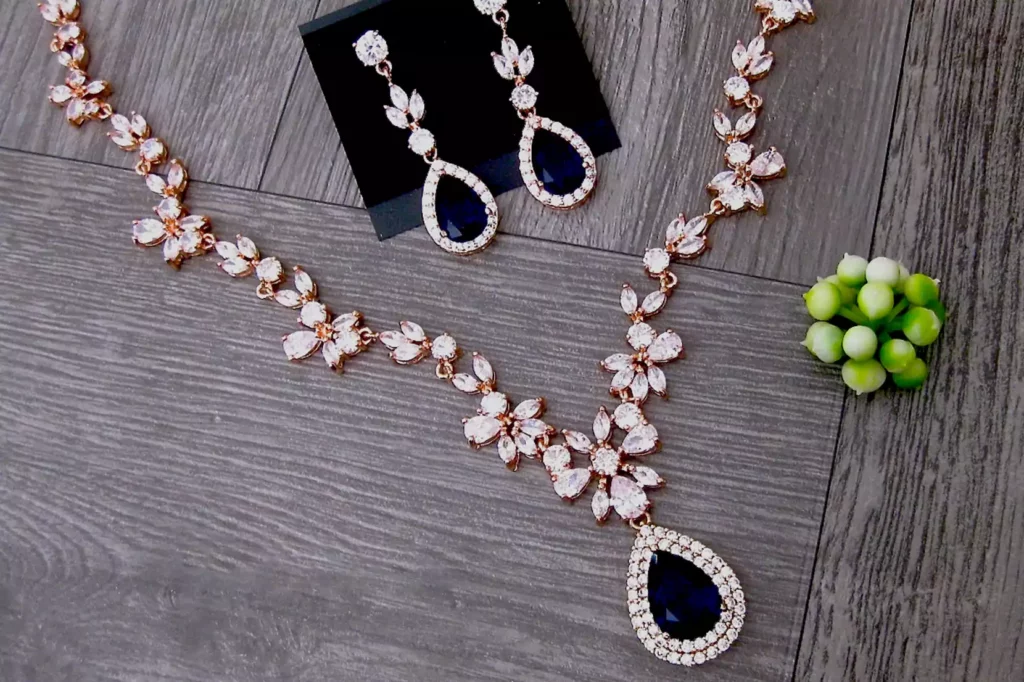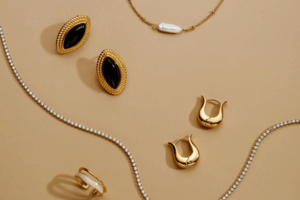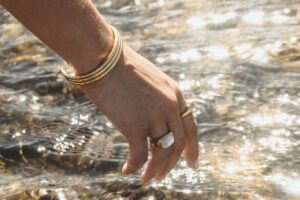Before investing in any piece of fine jewelry, it’s essential to have some background knowledge — especially with metals like rose gold. Understanding its composition and how it compares to other gold types can help you avoid counterfeits and ensure long-lasting value.
This guide will help you make a more informed buying decision, learn whether rose gold is real gold, and recognize the unique characteristics that make rose gold jewelry so desirable.
What Is Rose Gold?

Rose gold is an alloy of gold, copper, and sometimes silver. An alloy is a metal created by mixing two or more metals. Rose gold has a gold-tinged pink hue resulting from the combination of copper and silver with pure gold. An easy way to identify lower-carat rose gold is that it will appear pinker due to the presence of more copper, while those that have a more golden appearance contain more gold and therefore have a higher karatage.
What is Rose Gold Made of?
Is rose gold pure gold? No, rose gold is not pure gold. Rose gold composition, as stated earlier, is made up mainly of copper, pure gold, and small amounts of silver.
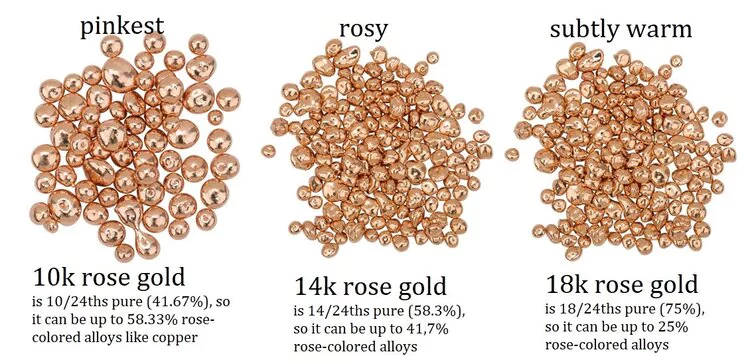
- Composition
The composition of a rose gold item depends on its karatage. The percentage of gold in 10K rose gold is 41.7%, along with copper, silver, and other metals. 20% silver and 38.3% copper are the most common alloy compositions used in making 10K rose gold. 14K rose gold is composed of about 58% pure gold, 42% copper, and about 2% silver. 18K rose gold has 75% gold, 22.25% copper, and 2.75% silver. The most expensive rose gold alloy, 22K rose gold, is made up of an alloy of 91.66% gold and 8.33% copper.
- How it’s Made
Rose gold jewelry is made by fusing specific quantities of gold, copper, and silver. The final color of the product is determined by the amount of copper and silver used.
Rose Gold vs Yellow Gold: Key Differences
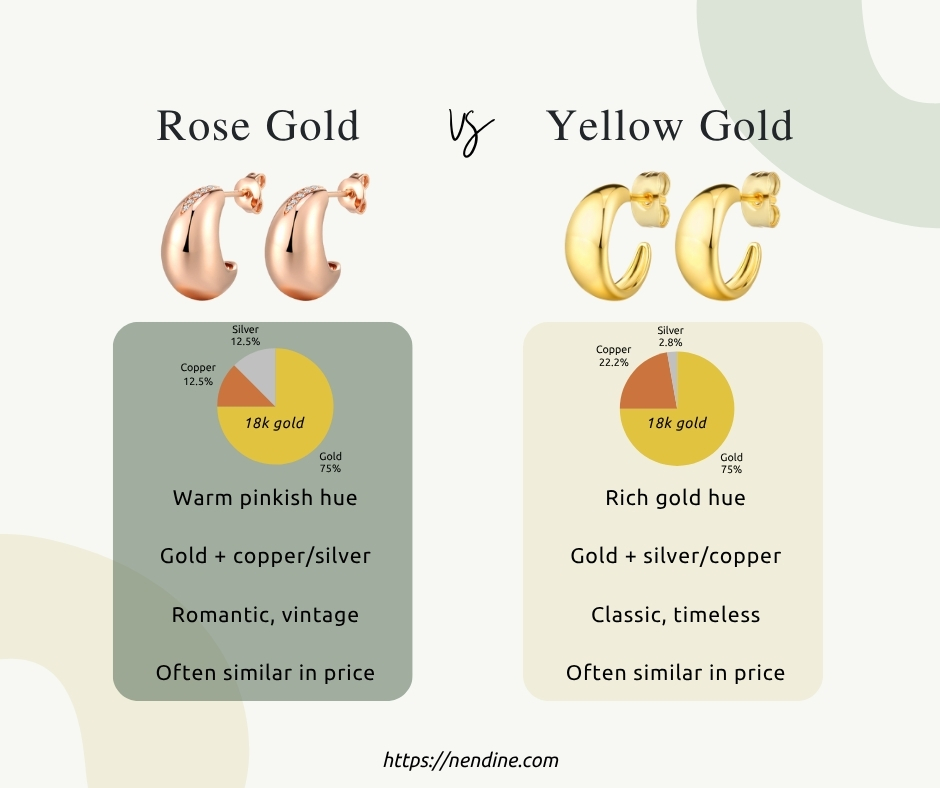
Is rose gold better than gold? Well, choosing between rose gold and yellow gold comes down to personal style, durability, and how each metal complements your skin tone or gemstones. Here’s how these popular gold types compare:
| Feature | Rose Gold | Yellow Gold |
| Color | Warm pinkish hue | Rich gold hue |
| Composition | Gold + copper (sometimes silver) | Pure gold + silver/copper alloy |
| Durability | Durable | Durable |
| Style Aesthetic | Romantic, vintage, trendy | Classic, timeless |
| Maintenance | Easy to care for | Minimal cleaning needed |
| Popularity | Increasingly trendy | Always in style |
| Price | Often similar in price | Often similar in price |
Does Rose Gold Tarnish Easily?
Because of its composition, rose gold is resistant to tarnishing and corrosion. As a result, unlike other types of jewelry, it will not tarnish or corrode quickly, but can eventually after long time wear and tear.
What Does Tarnished Rose Gold Look Like?
Tarnished rose gold can appear darker or duller, with a slight brownish tint. Over time, you may notice a minor hue change. This is due to the jewelry’s growing thin layer of metal “patina” on its surface. This layer of patina dulls the surface of the alloy.
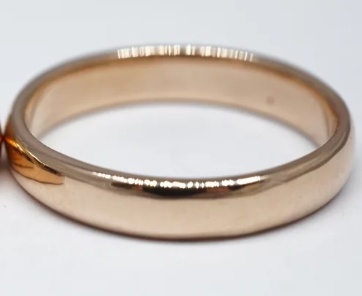
How to Clean Rose Gold Jewelry (Without Damaging It)?
Even though rose gold is extremely durable, harsh chemicals and strong jewelry cleaners can still damage it. If you wear rose gold jewelry frequently, it is advisable that you gently clean it once a month to restore its brightness.
In general, rose gold jewelry can be cleaned similarly to other gold jewelry, but it’s important to take precautions. Here are a few methods to follow in cleaning your rose gold jewelry:
Method 1: Washing With Soap and Water
You can safely clean rose gold jewelry at home using mild soap and water. This method works well for most rose gold pieces. Here’s a step-by-step guide for using this method:
- Line a bowl with a soft cloth or towel to prevent scratches.
- Fill the bowl with warm (not hot) water and a few drops of mild dish soap.
- Soak the jewelry for about 5–10 minutes. For dirtier pieces, soak longer.
- Gently clean with your fingers or a soft-bristled toothbrush.
- Rinse thoroughly with lukewarm water.
- Dry with a lint-free cloth, like microfiber, to prevent water spots.
Method 2: Using Vinegar and Salt
This mixture is very corrosive and should not be used when your rose gold jewelry has gemstones or diamonds on it. Here’s a step-by-step guide for using this method:
- Dry thoroughly with a lint-free cloth.anual to guide you on how to apply them to your jewelry without damaging it.
- Pour white distilled vinegar into a small bowl.
- Add salt, stirring until it no longer dissolves (this creates a saturated solution).
- Soak jewelry for 30–60 seconds — no longer.
- Rinse immediately with lukewarm water.
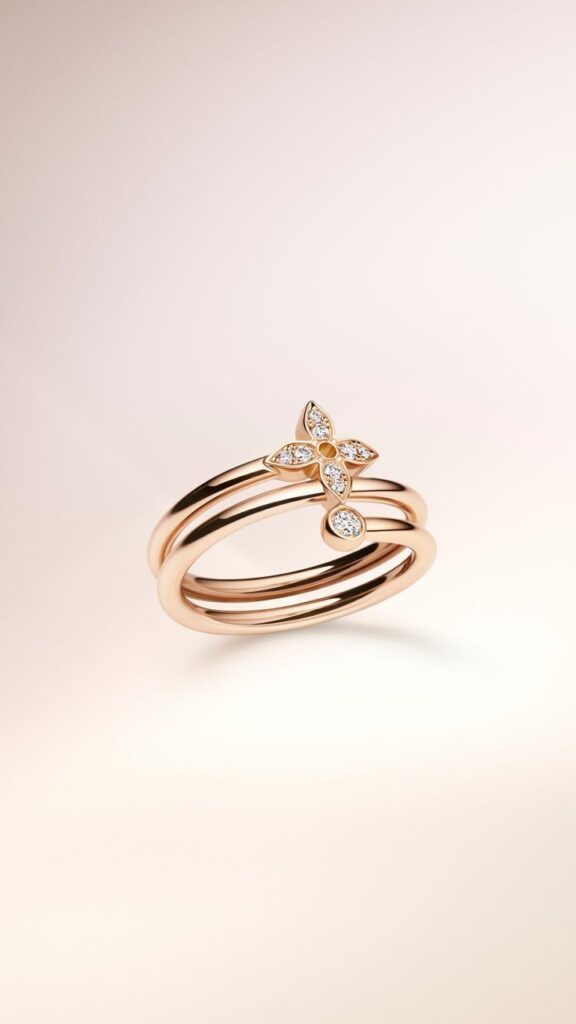
What Color Does Rose Gold Go With?
Rose gold is a color that blends well with an array of colors, whether in clothing or for other complementary jewelry. Its soft hue allows it to accommodate more vibrant tones in order to give a sophisticated overall design. It also goes well with neutral colors such as gray, white, or black, which provide a balance to the brilliance of the metal.
Let’s quickly examine a few of the many colors that go well with rose gold
- Gold
Rose gold complements yellow gold beautifully. This is a common quandary for folks who want to complement their rose gold attire with jewelry. However, don’t worry, the colors don’t clash. In truth, the softness of rose gold and the aggressiveness of yellow gold complement each other. This color combination is quickly becoming a trend because it adds a sense of savoir-faire to one’s attire.
- Pink
All shades of pink, whether in jewelry or clothing, go well with rose gold. Rose gold in itself has a pink color. Therefore, the combination of rose gold with pink gemstones such as morganite, pezzottaite, pink opal, and so on, or pink clothing, creates a visual progression through various shades of pink, which can be aesthetically pleasing. There is no clashing because they are essentially tones of the same color.
- Transparent Crystal
Rose gold looks great with crystal quartz. The brightness of crystal quartz contrasts nicely with the softer shine of rose gold, creating a kind of calm background against the harsher glimmer of crystal stones.
Key Takeaway
Rose gold jewelry blends elegance and resilience, making it a perfect choice for everyday wear or special occasions. Its warm tone and lasting appeal suit a wide range of styles.
If you’re looking to create a one-of-a-kind piece, working with a reputable custom jewelry manufacturer ensures expert craftsmanship tailored to your vision.
FAQs
Rose gold jewelry of good quality will last for years. Its strength comes from the copper mixed with pure gold, which makes it more resistant to scratching and bending.
Yes. Rose gold is a real form of gold made by alloying pure gold with copper and sometimes silver. The amount of gold depends on the karat (e.g., 14K rose gold contains 58.5% pure gold). You can quickly determine if rose gold is plated by looking for the hallmark and stamping. You can get stamps indicating 14K, 750, or 18K.
Not necessarily. The price of rose gold and yellow gold depends mainly on the karat (gold purity) and current gold market rates. The price of rose gold jewelry is typically the same as yellow gold with the same karat purity.
Rose gold is a type of gold, but it differs from yellow gold due to its added copper content. This alloy gives it a distinct pinkish hue, making it different in both color and durability.
